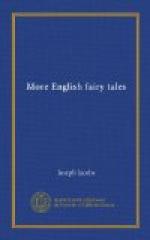LI. SIR GAMMER VANS
Source.—Halliwell’s Nursery Rhymes and Tales.
Parallels.—There is a Yorkshire Lying Tale in Henderson’s Folk-Lore, first edition, p. 337, a Suffolk one, “Happy Borz’l,” in Suffolk Notes and Queries, while a similar jingle of inconsequent absurdities, commencing “So he died, and she unluckily married the barber, and a great bear coming up the street popped his head into the window, saying, ’Do you sell any soap’?” is said to have been invented by Charles James Fox to test Sheridan’s memory, who repeated it after one hearing. (Others attribute it to Foote.) Similar Lugenmaerchen are given by the Grimms, and discussed by them in their Notes, Mrs. Hunt’s translation, ii., pp. 424, 435, 442, 450, 452, cf. Crane, Ital. Pop. Tales, p. 263.
Remarks.—The reference to venison warrants, and bows and arrows seems to argue considerable antiquity for this piece of nonsense. The honorific prefix “Sir” may in that case refer to clerkly qualities rather than to knighthood.
LII. TOM HICKATHRIFT
Source.—From the Chap-book, c. 1660, in the Pepysian Library, edited for the Villon Society by Mr. G.L. Gomme. Mr. Nutt, who kindly abridged it for me, writes, “Nothing in the shape of incident has been omitted, and there has been no rewriting beyond a phrase here and there rendered necessary by the process of abridgment. But I have in one case altered the sequence of events putting the fight with the giant last.”
Parallels.—There are similar adventures of giants in Hunt’s Cornish Drolls. Sir Francis Palgrave (Quart. Rev., vol. xxi.), and after him, Mr. Gomme, have drawn attention to certain similarities with the Grettir Saga, but they do not extend beyond general resemblances of great strength. Mr. Gomme, however, adds that the cartwheel “plays a not unimportant part in English folk-lore as a representative of old runic faith” (Villon Soc. edition, p. xv.).
Remarks.—Mr. Gomme, in his interesting Introduction, points out several indications of considerable antiquity for the legend, various expressions in the Pepysian Chap-book ("in the marsh of the Isle of Ely,” “good ground"), indicating that it could trace back to the sixteenth century. On the other hand, there is evidence of local tradition persisting from that time onward till the present day (Weaver, Funerall Monuments, 1631, pp. 866-7; Spelman, Icenia, 1640, p. 138; Dugdale, Imbanking, 1662 (ed. 1772, p. 244); Blomefield, Norfolk, 1808, ix., pp. 79, 80). These refer to a sepulchral monument in Tylney churchyard which had figured on a stone coffin an axle-tree and cart-wheel. The name in these versions of the legend is given as Hickifric, and he is there represented as a village Hampden who




